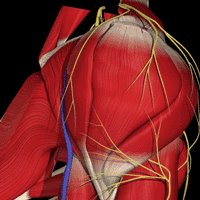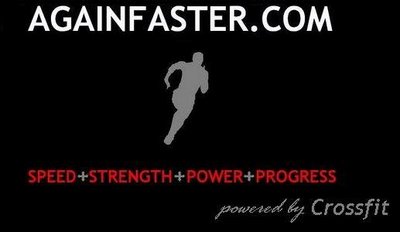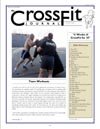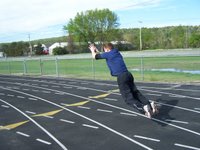On Point

The Hero workout was killing me. Movement after movement, my right shoulder felt like it was going to explode.
The pain was a dull ache turned up to ten, a thousand vice grips squeezing in concert. I sucked air through my teeth, doing my damndest to hide my agony, grunts and squeaks betraying my stoic front.
Five days earlier, I’d made a point of playing through the pain. Push presses came up on the calendar and ego overrode good sense, driving me to boost a cumulative load of 1800 pounds over my head. I was so pumped by the effort that I returned later that day, squatting my way through eight sets of Gayle Hatch-prescribed madness.
The next day, I swallowed half a bottle of ibuprofen and went to the Facility. I could’ve stayed in bed, but the siren song of a record attempt got me up at 4:30. 51 push-ups and 31 pull-ups later, I basked in the glow of a second personal record in as many days.
Through three more workouts and a bout of mid-November rock climbing, my shoulder never forgave me.
Monday brought “J.T.”, a Hero workout named for Petty Officer 1st Class Jeff Taylor. J.T. was one of eleven Navy SEALs killed in action during a 2005 engagement in Afghanistan, forever memorialized with an eponymous Crossfit workout.
Twenty-one ring dips, twenty-one push-ups, and twenty-one handstand push-ups, repeated for rounds of fifteen and nine. Pushing, pushing, and more pushing. Every repetition was a salvo at my will to live.
Handstand push-ups turned into barely controlled negatives turned into piked push-ups. I rolled to the floor after the last rep, my cheek smashing into the rubber flooring.
That evening, I attempted self-diagnosis. A PVC pipe in hand, I pressed overhead, waiting for the pain. It came when I shrugged my shoulders into the proper lockout position. Neal, now familiar with my problem due to days of incessant bitching, was across the room.
“Neal! I found the problem. It’s my trap.”
Neal looked at me like I was clearly the dumbest guy on earth and wandered over. Placing his thumb on my right trapezius, he pushed down hard.
“Yeah. That’s it. That fucking hurts.”
The understatement of the year. He might as well have soaked a screwdriver in hydrochloric acid and plunged it into my neck.
I had a classic trigger point—a permanent muscle contraction that manifests itself as pain in a remote site. The knots in my trap were putting tension on my shoulder, leading to a dull ache through my rear deltoid. I silently thanked my stars that the problem wasn’t structural, and conned my girlfriend into massaging the ever-living hell out of my neck.
The first session was agonizing. I was reduced to gritting my teeth and kicking the bed while Sam put all her weight on my trap. She apologized repeatedly for helping me while I loudly cursed her existence, stifling the urge to cry. The treatment brought immediate relief to my shoulder, primarily due to the throbbing pain in my neck.
The next day my symptoms were nearly gone.
Trigger points are non-intuitive. No one thinks, “Hey, my knee hurts. Must be a knot in my quadriceps.” I originally read about trigger points in the September 2005 Crossfit Journal. The idea that pain can be distal from its source meshes with the now-popular conception that all muscles are linked through fascia. Fascia is a network of connective tissue that surrounds muscles, giving support above and beyond that provided by bones and cartilage.
Given that all muscles are connected to one another via fascia, it makes sense that permanent contractions in one area could lead to pain in another. When this is taken as fact, the value of self-myofascial release becomes blindingly obvious.
Although I know very little about treating trigger points, there are a few sources out there that have garnered an enthusiastic following. Thomas Meyers’ Anatomy Trains is an extremely well-received work on the fascial system, recommended to me by Eric Cressey of Excel Sport and Fitness. Cressey knows a few things about shoulders and pain relief, and I have no doubt he’s right on with this recommendation.
Clair Daives’ Trigger Point Therapy Workbook is written for those of us who didn’t attend medical school, providing simplified maps of common trigger points and guides for self-treatment. If you’d rather not part with fifteen dollars, Mr. Davies also maintains a website full of useful information, complete with an index of common trigger points.
I’ll be picking up these books as soon as the next AF Bar order hits my inbox. Davies’ book is less than my co-pay for an office visit, and I won’t have to endure any enthusiastic probing from a misdirected thermometer. Man, I hate the doctor.
Go faster!
Picture courtesy of human-anatomy.net.

The Hero workout was killing me. Movement after movement, my right shoulder felt like it was going to explode.
The pain was a dull ache turned up to ten, a thousand vice grips squeezing in concert. I sucked air through my teeth, doing my damndest to hide my agony, grunts and squeaks betraying my stoic front.
Five days earlier, I’d made a point of playing through the pain. Push presses came up on the calendar and ego overrode good sense, driving me to boost a cumulative load of 1800 pounds over my head. I was so pumped by the effort that I returned later that day, squatting my way through eight sets of Gayle Hatch-prescribed madness.
The next day, I swallowed half a bottle of ibuprofen and went to the Facility. I could’ve stayed in bed, but the siren song of a record attempt got me up at 4:30. 51 push-ups and 31 pull-ups later, I basked in the glow of a second personal record in as many days.
Through three more workouts and a bout of mid-November rock climbing, my shoulder never forgave me.
Monday brought “J.T.”, a Hero workout named for Petty Officer 1st Class Jeff Taylor. J.T. was one of eleven Navy SEALs killed in action during a 2005 engagement in Afghanistan, forever memorialized with an eponymous Crossfit workout.
Twenty-one ring dips, twenty-one push-ups, and twenty-one handstand push-ups, repeated for rounds of fifteen and nine. Pushing, pushing, and more pushing. Every repetition was a salvo at my will to live.
Handstand push-ups turned into barely controlled negatives turned into piked push-ups. I rolled to the floor after the last rep, my cheek smashing into the rubber flooring.
That evening, I attempted self-diagnosis. A PVC pipe in hand, I pressed overhead, waiting for the pain. It came when I shrugged my shoulders into the proper lockout position. Neal, now familiar with my problem due to days of incessant bitching, was across the room.
“Neal! I found the problem. It’s my trap.”
Neal looked at me like I was clearly the dumbest guy on earth and wandered over. Placing his thumb on my right trapezius, he pushed down hard.
“Yeah. That’s it. That fucking hurts.”
The understatement of the year. He might as well have soaked a screwdriver in hydrochloric acid and plunged it into my neck.
I had a classic trigger point—a permanent muscle contraction that manifests itself as pain in a remote site. The knots in my trap were putting tension on my shoulder, leading to a dull ache through my rear deltoid. I silently thanked my stars that the problem wasn’t structural, and conned my girlfriend into massaging the ever-living hell out of my neck.
The first session was agonizing. I was reduced to gritting my teeth and kicking the bed while Sam put all her weight on my trap. She apologized repeatedly for helping me while I loudly cursed her existence, stifling the urge to cry. The treatment brought immediate relief to my shoulder, primarily due to the throbbing pain in my neck.
The next day my symptoms were nearly gone.
Trigger points are non-intuitive. No one thinks, “Hey, my knee hurts. Must be a knot in my quadriceps.” I originally read about trigger points in the September 2005 Crossfit Journal. The idea that pain can be distal from its source meshes with the now-popular conception that all muscles are linked through fascia. Fascia is a network of connective tissue that surrounds muscles, giving support above and beyond that provided by bones and cartilage.
Given that all muscles are connected to one another via fascia, it makes sense that permanent contractions in one area could lead to pain in another. When this is taken as fact, the value of self-myofascial release becomes blindingly obvious.
Although I know very little about treating trigger points, there are a few sources out there that have garnered an enthusiastic following. Thomas Meyers’ Anatomy Trains is an extremely well-received work on the fascial system, recommended to me by Eric Cressey of Excel Sport and Fitness. Cressey knows a few things about shoulders and pain relief, and I have no doubt he’s right on with this recommendation.
Clair Daives’ Trigger Point Therapy Workbook is written for those of us who didn’t attend medical school, providing simplified maps of common trigger points and guides for self-treatment. If you’d rather not part with fifteen dollars, Mr. Davies also maintains a website full of useful information, complete with an index of common trigger points.
I’ll be picking up these books as soon as the next AF Bar order hits my inbox. Davies’ book is less than my co-pay for an office visit, and I won’t have to endure any enthusiastic probing from a misdirected thermometer. Man, I hate the doctor.
Go faster!
Picture courtesy of human-anatomy.net.




















0 Comments:
Post a Comment
<< Home